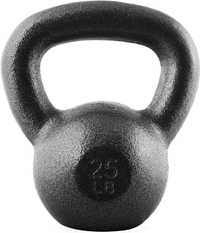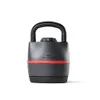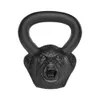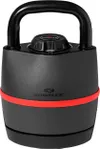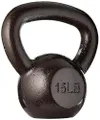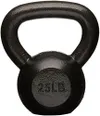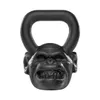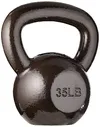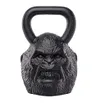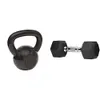
I love a kettlebell swing — whether it’s a Russian or American kettlebell swing, a lateral swing, or the single-arm variation, I’m always down to pick up a kettlebell and clock up the reps.
We’ve completed a fair few fitness challenges at Tom’s Guide, and one I hadn’t gotten around to trying out was the single-arm kettlebell swing, so I decided to program 70 reps a day for seven days using one of the best kettlebells for weightlifting.
Here’s how to do the single-arm kettlebell swing, the benefits and what happened when I charged up the reps and swung my way through the week.
CAP Kettlebell: from $21 @ Amazon
This kettlebell is made of high quality cast iron with no weld or seam casting. It's coated in an industrial enamel paint for enduring protection. It's perfect for swings, deadlifts, squats, get ups, snatches, and other athletic/cross training workouts. It's available in various sizes.
How to do single-arm kettlebell swings
First, I recommend learning how to do a kettlebell swing and how to hold a kettlebell properly. Once you feel comfortable with at least 10-15 reps, the single-arm swing is a more advanced variation you can try. Start by performing reps with one arm, then complete reps using the other arm. When that feels comfortable, try exchanging the kettlebell in the air and alternating arms.
How:
- Stand with your feet slightly wider than shoulder-width apart and place the kettlebell between your legs
- Softly bend your knees, engage your core and set your shoulders back and down
- Keep a neutral spine and flat back, hinge forward at the hips and send your bum back
- Grip the kettlebell with one hand and swing it between your legs
- Drive the kettlebell upward to shoulder height. As the kettlebell travels upward, stand tall and squeeze your glutes
- At shoulder height, transfer the weight to your other hand, catching it in an overhand grip
- Control the weight down, swing the weight between your legs, then continue into the next rep, alternating each time if you can.
I did 70 single-arm kettlebell swings every day for one week — here's what happened
Here are my results.
You can't switch off when you switch hands
Give me a kettlebell, and I’ll raise you a single-arm kettlebell swing to get the shoulders going any day of the week. So, that was me as I powered and swung my way through the reps. Previous kettlebell challenges have involved higher rep ranges — 90 or 100 — but I’ve been training alongside this one so I chose seven sets of 10 instead.
Sign up to get the BEST of Tom's Guide direct to your inbox.
Get instant access to breaking news, the hottest reviews, great deals and helpful tips.
The single-arm swing can be done one arm at a time, but you can alternate arms midair as you swing, so only one hand at a time makes contact with the bell as you release and catch to exchange the weight. It takes stability, balance and control, core work and an ability to coordinate.
That means the mind-muscle connection gets tested, along with the ability to perform unilateral (single-sided) exercise, emphasizing one side of the body at a time while teaching the muscles to recruit together. You can’t switch off, as I found out, and I had to focus on my mind and muscles the whole time.
I had to lift slightly lighter
The instability created by controlling the weight using one arm at a time meant I took it down a few lbs from my regular working weight. I used the EMOM format — every minute on the minute — meaning I completed seven sets totaling seven minutes and 10 reps within each minute.
I don’t mind this; I try to incorporate unilateral resistance training into my routine wherever I can. As mentioned, it can improve stability, coordination and balance, and research has shown it could elicit cross-education, which means untrained muscles can be indirectly stimulated by a movement working the other side of the body.
I could feel the move down the back of my body
Kettlebell swings of any kind, whether you’re trying lateral swings, American swings, or another kind, work your core and require you to engage your core properly to protect your back. Your core network — the deeper core muscles, glutes, erector spinae and hip flexors — will help you out here to try and stabilize the torso and spine during movement.
Swings target muscles everywhere, including your abs, shoulders, hips and arms, and primarily the posterior chain muscles, like the lower back, glutes and hamstrings. A high rep count could cause a sore back, so it’s crucial to keep your stomach braced and check in with your current ability level before adopting high reps during workouts.
I feel comfortable with 70 reps and set a week (no shorter, no longer) because it’s what I’m used to — don’t follow suit unless you’re confident with it. I also focused on squeezing my shoulder blades together and flattening my back during every rep — hunching will just get you hurt.
Verdict
By day seven, my whole body was on fire, and it was time to wrap up. I’m practiced enough with kettlebell swings of all kinds to know my limit and to check in with my body throughout, ensuring I’m engaging the correct muscle groups at the correct time.
That said, 490 reps later, my stomach, glutes and shoulders were cooked. It’s really easy to lose glute engagement during swings, so if I could pass on any advice for those giving them a go, it’s to use a gentle hip snap as you drive the weight up and give your glutes a healthy squeeze without putting all the load into your arms.
More from Tom's Guide
- I'm a personal trainer, this one-minute stretch opens your hips and builds lower body flexibility
- 7 best kettlebell ab exercises for strengthening your core muscles
- Forget pull-ups — chisel your back and biceps muscles with these 5 dumbbell exercises

Sam Hopes is a level 3 qualified trainer, level 2 reiki practitioner and senior fitness writer at Tom's Guide. She is also currently undertaking her Yoga For Athletes training course. Sam has written for various fitness brands and websites over the years and has experience across brands at Future such as Live Science, Fit&Well, Coach, and T3.
Having worked with fitness studios like F45 and Virgin Active, Sam now primarily teaches outdoor bootcamps, bodyweight, calisthenics and kettlebells. She also coaches mobility and stretching-focused classes several times a week and believes that true strength comes from a holistic approach to training your body.
Sam has completed two mixed doubles Hyrox competitions in London and the Netherlands and finished her first doubles attempt in 1:11.
